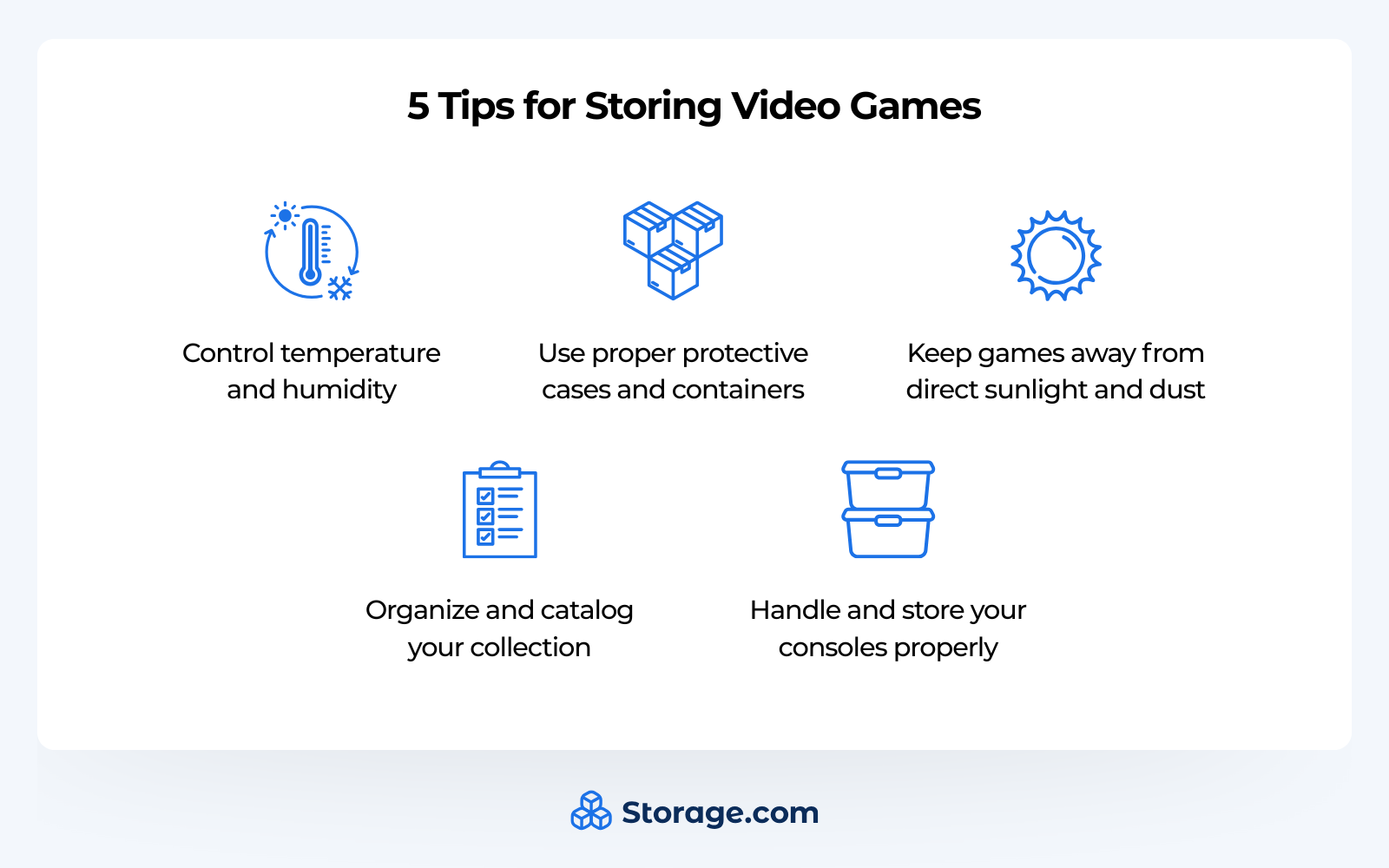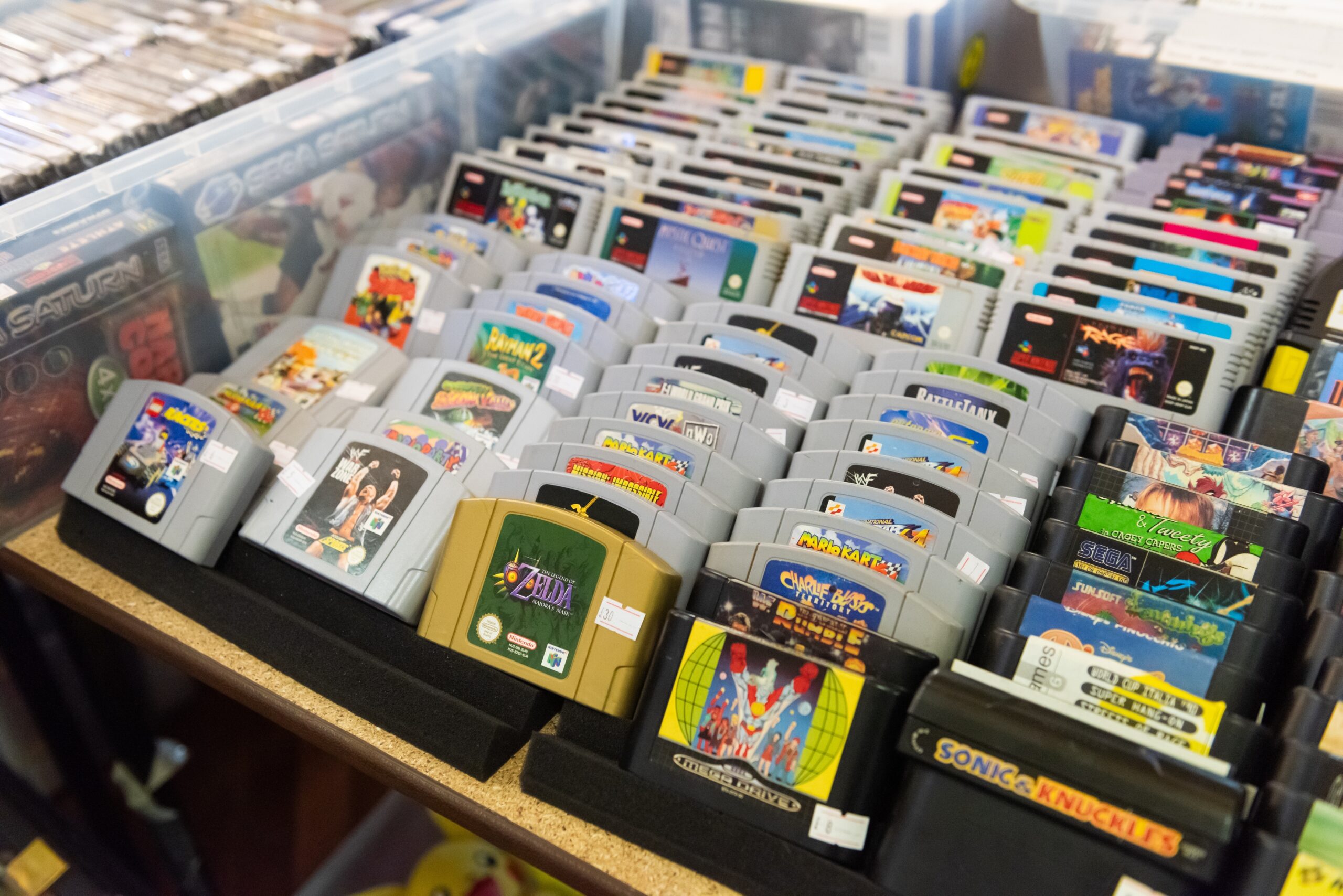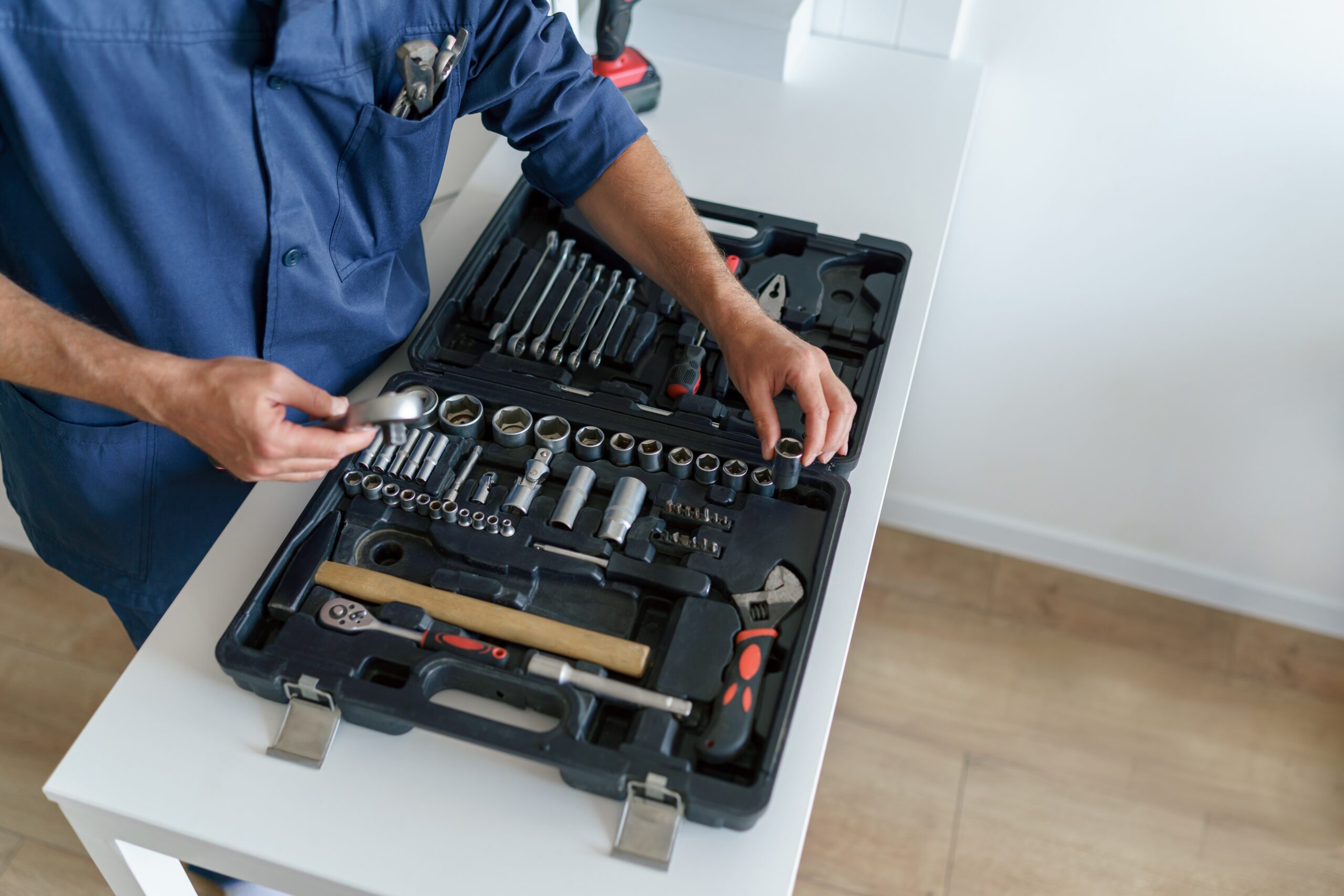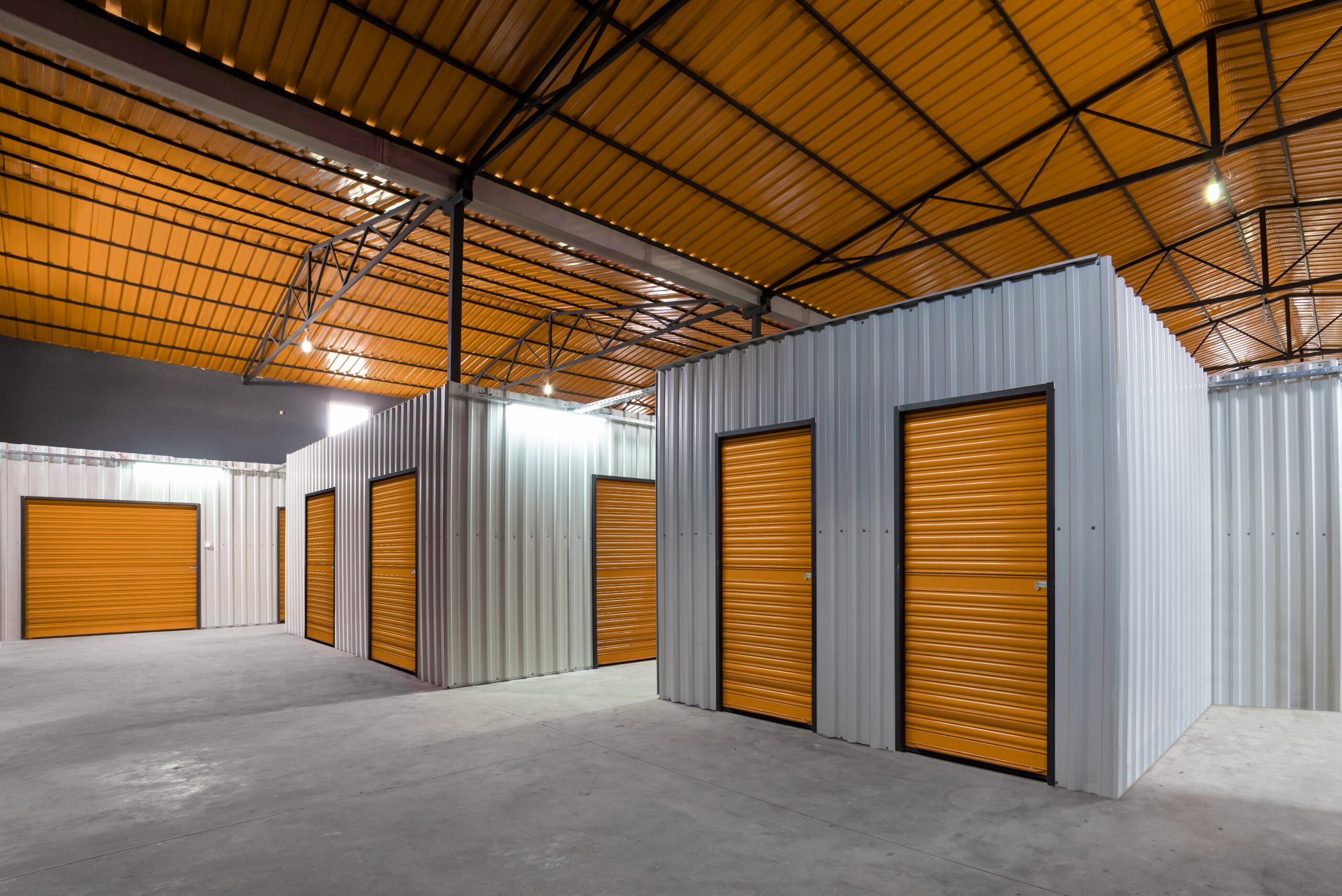Article takeaways
- Video games and consoles are vulnerable to heat, cold, humidity, sunlight, and dust, which can damage them.
- Store games and consoles in a climate-controlled space, catalog them for insurance and organization purposes, and use proper protective packaging to keep environmental damage away.
- For best results, including longevity and security, store your video game collection in a climate-controlled storage unit.
Video game collections, like any other media collection, can be precious. For some, they hold sentimental value or serve as a reminder of the games they grew up on; for others, they’re collectors’ items that can be rarer and more valuable than one might expect.
No matter why you collect video games or consoles, though, it can be difficult to protect a collection from dust, moisture, temperature changes, and mishandling, especially if you don’t have a lot of space in your house.
In this article, we’ll outline five steps to keep your game collection clean, pristine, and ready to play: controlling temperature and humidity, storing them in protective cases, keeping them out of direct sunlight and away from dust damage, organizing them effectively, and handling consoles with care.
We’ll also look at how climate-controlled storage units can be a perfect solution for collectors looking to preserve games of any era.

1 – Control temperature and humidity
The older your games and consoles are, the more susceptible they are to damage from the environment. High heat can warp discs and damage pieces of game cartridges, humidity can lead to mildew and corrosion, and low temperatures can make cases and plastic cartridges brittle.
Always store your games between 60-70°F (15-21°C) and 30-50% relative humidity if you have a good HVAC system and humidifier on hand. These tips also go for newer games; while they may hold up a little better to weather damage, they won’t last as long if they aren’t cared for.
Interior closets are good places to store smaller game collections, and if you have access to a climate-controlled room, that’ll be your best option. Never store games in an attic, basement, or garage, as they’re some of the most susceptible rooms to heat and humidity.
For best results, rent a climate-controlled storage unit; they come in many sizes to fit your needs, such as 3’ x 3’ storage lockers for smaller sets of games and 5’ x 5’ full-size units that can fit a larger collection.
2 – Use proper protective cases and containers
If you’re preparing a video game collection for storage, you’ll find that most games on discs and cartridges will be best protected in their original packaging. However, older cartridge boxes and jewel cases may benefit from some extra protection so the cases themselves won’t be damaged.
Let’s go over the best practices for preserving different kinds of physical game media.
Cartridges, such as NES, N64, Game Boy, and Switch
The original boxes for game cartridges are valuable, but fragile. Use a plastic box protector or shrink wrap to better protect the cardboard. If you have loose games without boxes, get a plastic cartridge case to store them properly, and store everything in anti-static bags to protect them from unwanted shocks.
Discs, such as Wii, PlayStation, Xbox, and PC
Disc media is best protected in its original case. If the case is cracked, replace it and put the disc in a sleeve for extra protection. It’s best to store these games vertically on a shelf rather than stacking them flat on top of each other.
Other media and cases
Special edition steelbook game cases should be stored in protective sleeves. Always keep the original game box for resale value.
Make sure you label all of your storage methods clearly so you can easily find the games you need at any time.
3 – Keep games away from direct sunlight and dust
If you were a regular visitor to Blockbuster Video when it was open, you may have noticed the faded labels and art on some of the game and video cases near the windows. This is due to UV damage, and your own video game collection isn’t immune to this fading. Sunlight can also degrade plastic game cases over time, and if discs are directly exposed to it, they may become unreadable.
Dust is another common yet devastating cause of damage. If you let too much dust into your game and console collection, it can damage cartridge connectors and disc readers, and can corrode the metal contacts on cards and cartridges. Wiping dust off a disc surface can also lead to scratches.
To prevent sunlight and dust from ruining your collection, store your games away from direct sunlight and in an enclosed space if possible, like a closet, cabinet, or enclosed shelving unit. If you must use open shelving, get dust covers for your video game storage shelves to keep them clean, and regularly dust your discs and cartridges with microfiber cloths that won’t scratch the delicate surfaces.
4 – Organize and catalog your collection
Once you know your games and consoles are protected and cared for, make sure you organize them in a way that makes sense to you. Whether you do this by console, by franchise, by genre, or just alphabetically, choose a method that will allow you to easily find any game you’re looking for at any time. Label any boxes or shelves clearly so you won’t get lost or confused while searching through your collection.
You should also keep a thorough catalog of each of your games before moving them into any form of storage. This will help you keep track of everything you own and avoid making duplicate purchases, calculate the value of your collection for accurate insurance coverage, and help identify any items that are missing.
Keeping a log of where games are located also makes them easier to locate in your collection, and making a note of the condition of valuable games will give you a more accurate value. Look into third-party applications that allow you to store your catalog in the cloud and estimate the value of each of the items you have on hand.
5 – Handle and store your consoles properly
As with any other electronic devices, you should treat game console storage with extra care so their delicate internal parts aren’t damaged. Before you store any consoles, make sure you clean and dust them as thoroughly as possible, disconnecting all cables to prevent electrical damage. Take the batteries out of any wireless controllers to prevent corrosion, and update the firmware on any modern consoles you plan to use again in the future.
When packing up consoles for storage, try to use the original box and protective material whenever possible. If you don’t have those on hand, use bubble wrap or foam padding to pack a box with a console in it and prevent it from sliding around. Older consoles with circuits exposed should be stored in anti-static bags. Finally, make sure consoles are stored on their own without putting weight on top, as crushing damage is a common concern when putting electronic devices in storage.
When it comes to cables, make sure you bundle them separately from your consoles to save space, but label each one clearly so you know what goes with what. Use cable ties or velcro straps to keep cables tightly wrapped and prevent them from tangling with each other.
Controllers should be wrapped tightly with anti-static plastic wrap to keep dust from getting into the connectors and small openings where the buttons may be. If the buttons are “mushy” or don’t respond well to being pushed, clean around the button edges with a Q-tip and a small amount of rubbing alcohol to restore them before you put the controllers away.
When should I consider a storage unit for video game and console storage?
If you’re running out of space at home, want to declutter or downsize, or just need a climate-controlled environment to keep your video game collection safe, it may be time to look into renting a storage unit for your games. Here are a few features to keep an eye out for.
- Climate control. An enclosed storage unit is usually enough to protect your collection from sunlight, but for maximum protection from temperature and humidity damage, find a climate-controlled unit that keeps the environment within a predictable range of heat and moisture.
- Security features. Valuable collections will benefit from surveillance cameras, gated facility entry, and good locks. Set up an alarm system of your own for maximum peace of mind.
- Pest control. A reputable storage facility will have measures in place to keep insects, rodents, and other pests from damaging your collection or making nests in your boxes.
- Regular maintenance. Choose a facility that maintains a high standard of cleanliness and hygiene.
- 24/7 access. Most self-storage facilities allow renters to visit their units and check on the contents even when the leasing office is closed.
If the storage facility you choose allows you to bring your own lock, invest in a good disc lock to prevent anyone from breaking in. Keep a running, detailed catalog of your game inventory, and update it every time anything changes.
Make time to visit your unit every so often to check the condition of your games, and consider purchasing extra insurance to cover your collection in the event of an accident or crime.
How do I find the right storage unit for my video game storage needs?
Organizing, protecting, and storing your video game collection takes time and commitment, but if you follow our steps, your games and consoles will be in perfect condition for years to come.
Renting a climate-controlled unit for your collection provides even more protection and will keep you from having to replace valuable software and hardware down the road.
If you’re ready to seek out a unit near you, Storage.com can help! Use our built-in search tool to compare prices and sort by the features you need.






